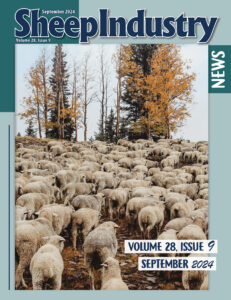LES BOIAN, 1948-2024
Lester Owen Boian of Springdale, Wash., passed away on July 5, 2024. He was 76 years old. He was born on May 31, 1948, to Robert “Owen” and Doris Boian.
Les was a steady, positive contributor to the Washington State Sheep Producers, in both short- and long-term planning. While shearing other people’s sheep, he was a great ambassador for WSSP, actively promoting membership in the organization.
He also served on several ASI councils and committees during his time in the industry.
He held the position of president for nearly 15 years of the Spokane (Wash.) Area Sheep Producers. In addition to producing their newsletter, he was instrumental in the group’s educational field day, where producers attend workshops and learn about current topics in sheep production.
As a young man, Les attended the University of Idaho. During this time, he became a herdsman at the Caldwell Sheep Experiment Station, where the head herdsman taught him to shear. He went on to shear sheep for more than 50 years, from Idaho to Spokane and the Seattle area.
He sometimes worked with a crew of two or three, shearing bands of 2,000 to 3,000 sheep. When things were going well, he was known to shear more than 100 sheep per day.
For many years, he farmed in Idaho with his dad and brother, where they had more than 1,000 sheep, as well as cattle. Later, he went to work for the Idaho Department of Agriculture as a milk plant specialist for 17 years.
For the last 20-plus years, he has been a milk specialist and then branch director for the Food and Drug Administration, responsible for Washington and 10 other states.
He was loved and cherished by many people including: his parents, Robert “Owen” Boian and Doris Boian; his wife Margie Lierman; his children, Marne Feucht (Jeremy) and Kelly Boian (Laurelle); and his grandchildren, Kyle, Arielle, Tyler, Asher, Ryan and Kaitlyn.
In lieu of flowers, memorial donations can be made in Les’ memory to the University of Idaho Department of Agricultural and Extension Education.
CHARLES PARKER, 1935-2024
Charles F. Parker, 89, of Columbus, Ohio, died suddenly of heart complications at Riverside Hospital on July 19, 2024.
He was born Feb. 25, 1935, at Winterset, Ohio. He married Carol Ackerman on Sept. 3, 1955. They are the parents of three sons, Jeffrey (deceased), Stephen (Beth) of Galena, Ohio, and Darryl (Gena) of Rochester, Minn. He was a loving grandfather to four grandchildren, three great grandchildren, nieces and nephews. His sister, Carol Bateman, of Pleasant Hill, Calif., and brother-in-law, David Ackerman (Susan) of Maineville, Ohio, complete the family circle.
He played basketball and baseball in high school and had fond memories of playing on the Ohio State University freshman baseball team. He was an enthusiastic fisherman and avid Ohio State football fan.
Charles was proud of the family farm and of being a farm boy. He graduated high school in 1953 and enrolled at OSU, where he lived his first year in the scholarship dormitory then located in Ohio stadium.
He earned a degree majoring in population genetics, followed by graduate degrees at both Ohio State University and Texas A&M University.
He began his career as an animal science instructor at Ohio State. Other positions included director of the U.S. Sheep Experiment Station in Dubois, Idaho, and chairman of animal science at OSU.
He worked for ASI in the 1990s as director of producer services and director of production, education and research. He was also the recipient of ASI’s Camptender Award at the 2013 ASI Annual Convention in San Antonio.
He was an early proponent of the work of Michael Piel in the development of the Katahdin breed of sheep. In fact, an organizational meeting of what would become Katahdin Hair Sheep International was held at USSES at his invitation.
Charles was invited to speak to numerous agriculture groups, both nationally and internationally. He considered his trip to Mongolia as his most unique professional experience.
He enjoyed humor, especially with his grandchildren. He was a kind and friendly family man.


